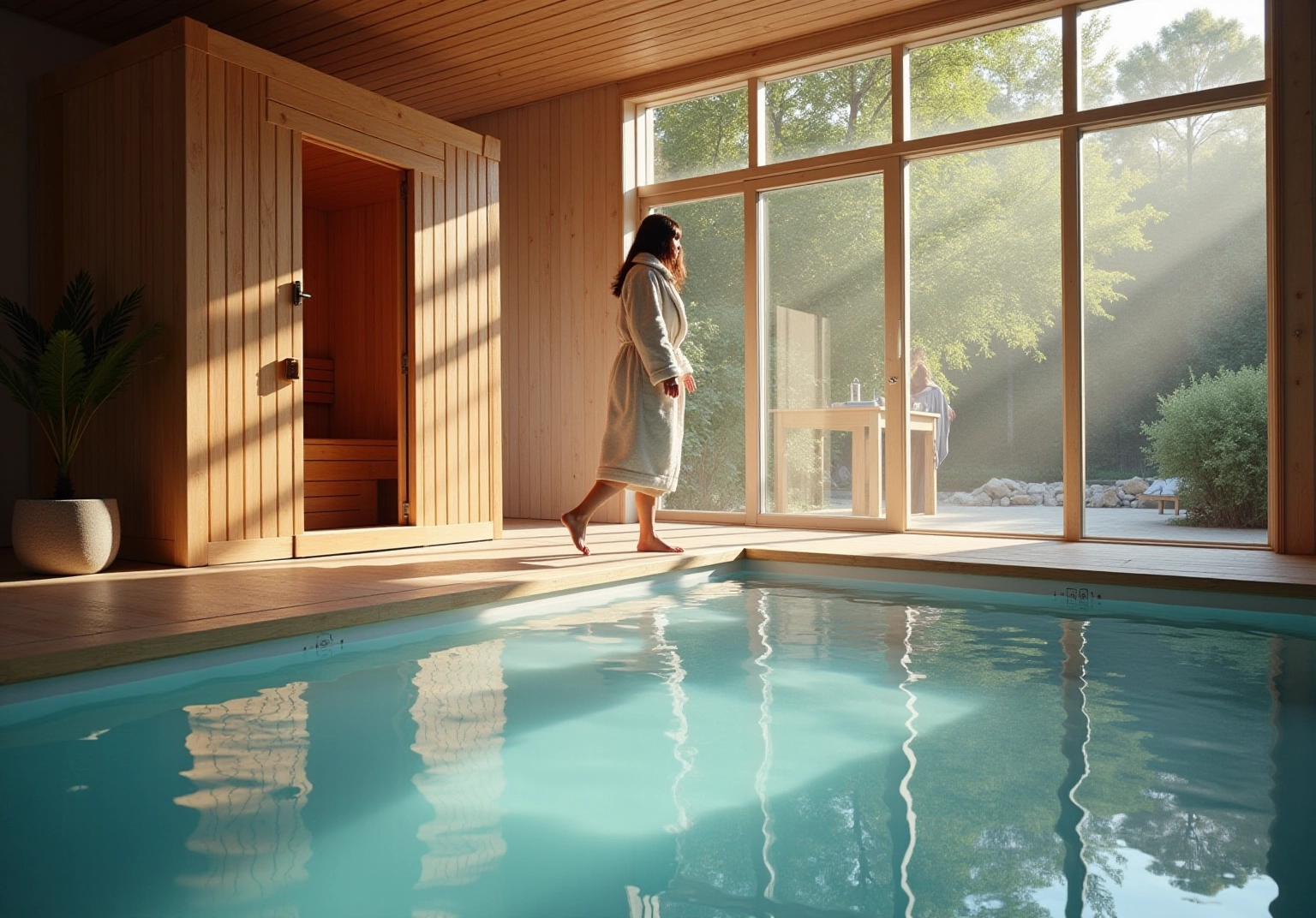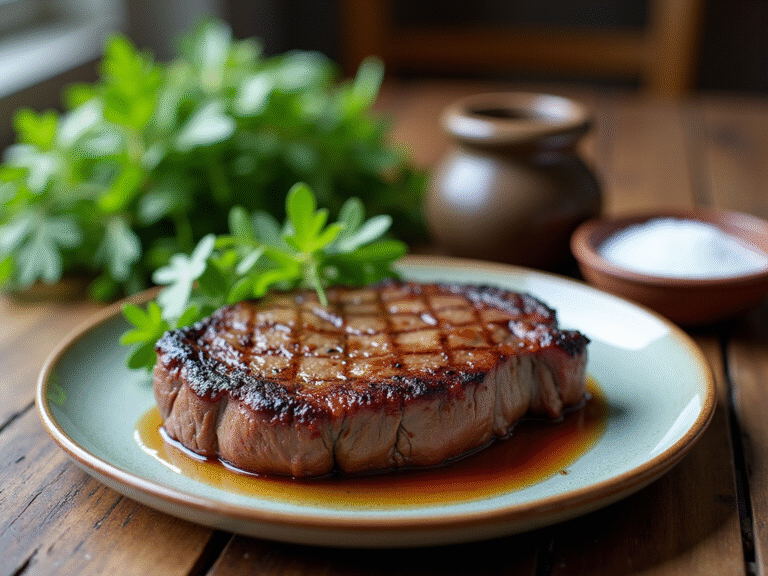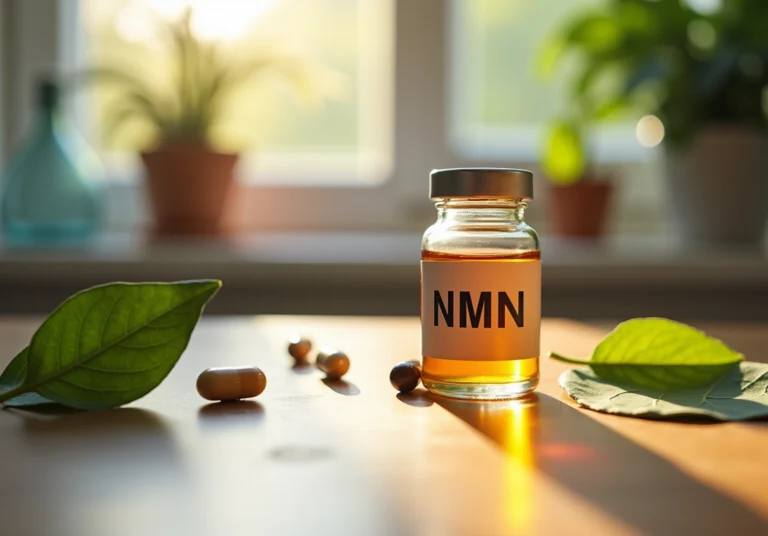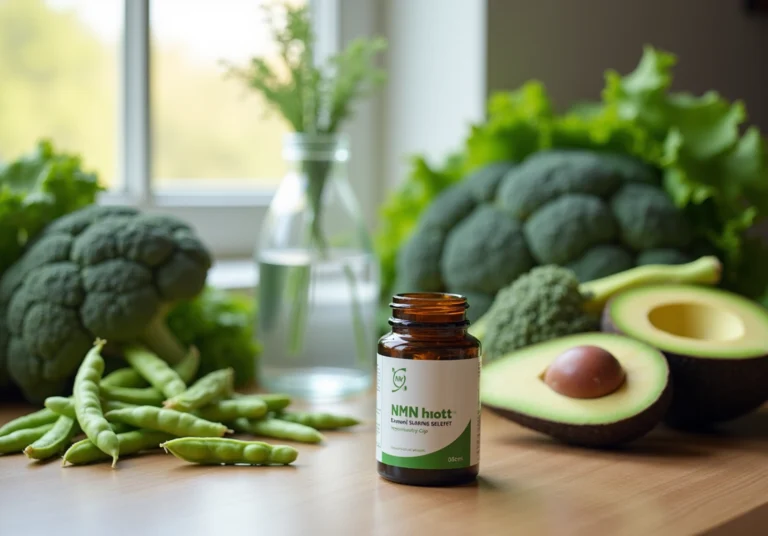7 Key Benefits of Sauna and Cold Plunge for Wellness
Overview
This article explores seven key benefits of sauna and cold plunge therapies that contribute to overall wellness. It emphasizes their positive effects on physical health, mental clarity, and emotional resilience. Specifically, sauna use is shown to boost immune function and promote relaxation. In contrast, cold plunges effectively reduce inflammation and enhance recovery. Together, these therapies represent a powerful approach to improving both physical and mental well-being.
Furthermore, the combination of sauna and cold plunge therapies not only aids in physical recovery but also supports mental health. By incorporating these practices into your routine, you can experience enhanced relaxation and resilience. As a result, exploring these therapies may lead to significant improvements in your overall wellness.
Introduction
The pursuit of wellness has led many individuals to explore innovative therapies that promise profound health benefits. Among these, sauna and cold plunge treatments stand out for their remarkable ability to enhance both physical and mental well-being. As more people seek holistic approaches to health, understanding how these contrasting therapies can work in tandem presents a unique opportunity for rejuvenation and vitality.
What if integrating these practices could elevate energy levels, fortify the immune system, and promote mental clarity? This article delves into the key benefits of sauna and cold plunge therapies, revealing how they can transform wellness routines and support a healthier lifestyle.
ByKomi: Enhance Your Wellness with Sauna and Cold Plunge Therapies
At ByKomi, we recognize the profound impact of comprehensive wellness approaches, especially through the benefits of sauna and cold plunge therapies. These practices not only enhance physical health but also foster mental clarity and emotional resilience. Regular sauna sessions, typically lasting 10-15 minutes, stimulate the production of white blood cells. This bolsters immune function and promotes relaxation through endorphin release. Simultaneously, chilly immersions, with temperatures around 10-15 degrees Celsius (50-59 degrees Fahrenheit), reduce muscle inflammation and discomfort, accelerating recovery after strenuous exercise.
The combination of these treatments, known as contrast methods, has gained popularity for its ability to enhance circulation by alternating between heat and chill exposure. This method improves cardiovascular health and supports detoxification by promoting lymphatic circulation. Furthermore, the refreshing shift from heat therapy to icy immersion can elevate energy levels and mental clarity, making it particularly beneficial before engaging in demanding tasks.
Health professionals advocate for the benefits of sauna and cold plunge as integral components of a balanced wellness routine, emphasizing their role in stress reduction and overall vitality. By incorporating the benefits of sauna and cold plunge therapies into your lifestyle, alongside a diet rich in quality animal-based foods reminiscent of the Hunza people’s nutritional practices, you can effectively support your journey towards healthy aging and rejuvenation. This approach aligns seamlessly with our mission at ByKomi to empower individuals through informed choices.
Sauna: Boost Circulation and Detoxification
Saunas significantly enhance blood flow and circulation, facilitating better oxygen delivery to tissues and promoting overall cardiovascular health. The heat produced during steam room sessions induces sweating, which plays a crucial role in detoxifying the body by eliminating harmful substances. Research, including the Kuopio Ischemic Heart Disease Risk Factor Study, indicates that regular use of heat therapy is associated with improved metabolic function and a notable reduction in the risk of chronic diseases such as cardiovascular conditions.
For instance, a long-term study involving over 2,300 middle-aged men showed that frequent users of heated bathing facilities had a 40% lower risk of all-cause mortality and a significantly reduced risk of fatal coronary heart disease. It is advisable to consult a healthcare professional before adding heat therapy to your routine, especially for individuals with pre-existing health conditions.
This makes sauna bathing a valuable addition to any wellness regimen, emphasizing the benefits of sauna and cold plunge for supporting both physical and mental well-being. Have you considered how the benefits of sauna and cold plunge could enhance your health? Explore further resources to learn more about the positive impacts of heat therapy.
Cold Plunge: Reduce Inflammation and Muscle Soreness
Cold immersions are highly effective in reducing inflammation and muscle soreness, particularly after intense physical activity. The immersion in cool water triggers vasoconstriction, decreasing swelling and facilitating the removal of metabolic waste products from the muscles. This physiological reaction not only speeds up recovery but also improves overall athletic performance, making icy immersions an essential tool for fitness enthusiasts.
Research indicates that athletes who integrate cool water immersion into their recovery routines report significant enhancements in perceived recovery and muscle function. For instance, a study found that participants who engaged in chilly immersions demonstrated improved power in explosive movements 24 hours post-exercise compared to those who did not. Furthermore, chilled immersions have been linked to a reduction in delayed onset muscle soreness (DOMS), allowing athletes to maintain their training intensity and frequency.
Significantly, participants who included 30-90 seconds of chill showering and consistently exercised experienced a 54% decrease in sick days compared to those who only took warm showers. Real-life instances abound, with numerous professional athletes incorporating chill immersion methods into their recovery routines to combat inflammation and accelerate muscle recuperation, underscoring its significance in contemporary athletic training.
In addition, chilly immersion treatment can enhance sleep quality and bolster the immune system, rendering it a versatile strategy for health and recovery. Have you considered how integrating cold immersions could benefit your own recovery routine?

Contrast Therapy: Enhance Immunity with Sauna and Cold Plunge
Contrast treatment, which involves alternating between heat sessions and experiences that highlight the benefits of sauna and cold plunge, has been shown to enhance immune function. This practice effectively stimulates the lymphatic system, aiding in the removal of toxins and boosting the body’s ability to combat infections. By regularly incorporating the benefits of sauna and cold plunge into your routine, you can significantly strengthen your immune defenses and promote overall health.
Have you considered the benefits of this practice? By embracing contrast treatment, which highlights the benefits of sauna and cold plunge, you not only support your immune system but also contribute to your overall well-being. Explore how this simple adjustment can lead to a healthier lifestyle.

Sauna: Alleviate Stress and Promote Mental Clarity
Sauna sessions are recognized for their ability to alleviate stress and enhance mental clarity. The soothing heat promotes relaxation and stimulates the release of endorphins, significantly improving mood and reducing anxiety levels. Research suggests that regular heat therapy is linked to a notable reduction in symptoms of depression. For instance, a study involving 30 participants who utilized the therapy twice a week for four weeks reported considerable decreases in depression symptoms, as assessed by the Beck Depression Inventory.
Furthermore, regular heat sessions have been associated with enhanced cognitive function, promoting better concentration and clearer reasoning. To maximize benefits and prevent dehydration, it is essential to stay hydrated before and after heat sessions. Personal experiences, like that of Sarah, who discovered considerable anxiety relief through thermal therapy, demonstrate its effectiveness in practical situations. This places steam rooms not merely as tools for physical wellness but as vital allies in mental health management.
For those new to sauna use, starting with shorter sessions at lower temperatures is recommended to build tolerance. By incorporating sauna therapy into your routine, you can explore the benefits of sauna and cold plunge for both mental and physical health.

Cold Plunge: Stimulate Immune Response
Cold plunges significantly stimulate the immune response by boosting the production of white blood cells, which are crucial for fighting off infections. The abrupt exposure to frigid water, typically between 50°F to 59°F, triggers a physiological reaction that enhances the body’s immune function. Research indicates that regular cool water immersion can lead to an increase in white blood cell count, thereby improving overall health and resilience against illness.
This practice can also help ease soreness by tightening blood vessels and minimizing inflammation, as it constricts blood flow to inflamed areas. Incorporating chilly immersions in your wellness regimen provides the benefits of sauna and cold plunge, enhancing immune function and serving as a proactive approach for illness prevention.
As you consider incorporating cold plunges into your routine, remember to start slowly with brief immersions of 30 seconds to 1 minute. Additionally, consult with a healthcare provider if you have any pre-existing health conditions.
Furthermore, ensure safety by having a ‘shore buddy’ present during your cold plunge sessions. By taking these precautions, you can enjoy the benefits of cold plunges while prioritizing your health.
Sauna: Activate Heat Shock Proteins for Cellular Health
Sauna use effectively activates heat shock proteins (HSPs), which are essential for cellular repair and protection. These proteins play a crucial role in mitigating cellular damage induced by stressors while enhancing the body’s resilience, ultimately promoting longevity.
Regular steam bath sessions have been associated with improved cellular health. Research suggests that consistent use can significantly strengthen the body’s capacity to handle various stressors. Therefore, sauna bathing emerges as a vital practice for individuals committed to healthy aging and overall well-being.

Cold Plunge: Improve Mood and Mental Health
Cold plunges significantly enhance mood and mental health by boosting the production of neurotransmitters like dopamine and norepinephrine, which are closely linked to feelings of happiness and well-being. Studies suggest that consistent exposure to frigid water can increase dopamine levels by as much as 250%. This increase results in enhanced motivation, concentration, and emotional strength. As a result, this surge in neurotransmitter activity not only alleviates symptoms of anxiety and depression but also fosters a sense of satisfaction and accomplishment, reinforcing positive behaviors. Research indicates that repeated exposure to frigid water can lessen cortisol release and subjective stress perception, aiding in improved stress management.
Furthermore, cold exposure activates the sympathetic nervous system, triggering the release of noradrenaline, which prepares the body for action and enhances performance. The mental clarity attained through chilly plunging creates ideal conditions for learning and memory retention, making it a potent tool for cognitive enhancement.
Psychologists highlight the transformative effects of chilly exposure on mental health. Overcoming the initial discomfort of ice baths can foster resilience and enhance emotional regulation. As Will Cronenwett, Chief of Psychiatry at Northwestern University School of Medicine, stated, “The primary mental health advantages of cool water immersion are psychological… It can be frightening, so when you are doing it, you are conquering your fear. This feels good, like mastering any difficult feat.”
By including chilly immersions in a wellness regimen, individuals can utilize the benefits of sauna and cold plunge. For optimal results, it is recommended to start with water temperatures around 50-59°F and durations of 2-5 minutes.
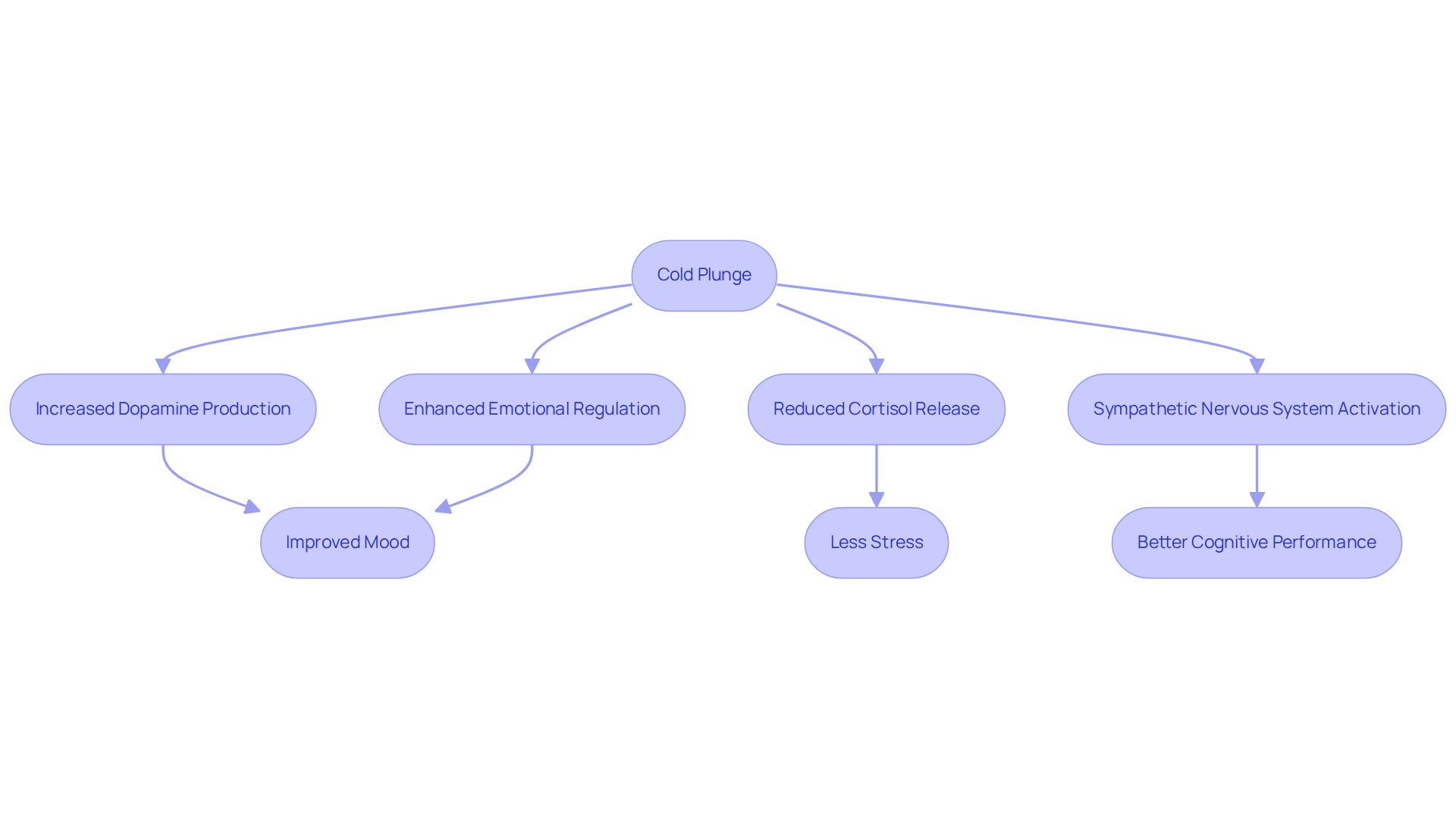
Combined Benefits: Enhanced Recovery and Pain Relief
The combination of heated room and chilled immersion therapies offers significant benefits of sauna and cold plunge for recovery and pain relief. The warmth from the sauna encourages muscle relaxation and boosts blood circulation, which is essential for delivering nutrients and oxygen to tired muscles. Conversely, the cold plunge effectively diminishes inflammation and numbs pain, providing immediate comfort. This alternating exposure to heat and cold not only accelerates recovery after strenuous workouts but also serves as a powerful strategy for managing chronic pain conditions.
Research indicates that the benefits of sauna and cold plunge, such as improved muscle recovery, reduced soreness, and enhanced overall wellness, make it a vital resource for athletes and individuals seeking effective pain management options. As Andrew Jagim, Ph.D., points out, “If you want to give cold-water immersion a try, start by consulting an expert to ensure you’re following the right protocol.”
To incorporate these treatments into your routine, consider beginning with:
- A 15-minute heat session
- A 2-5 minute cold immersion
Gradually increasing the duration as your body adapts. This approach not only optimizes recovery but also promotes a healthier lifestyle.
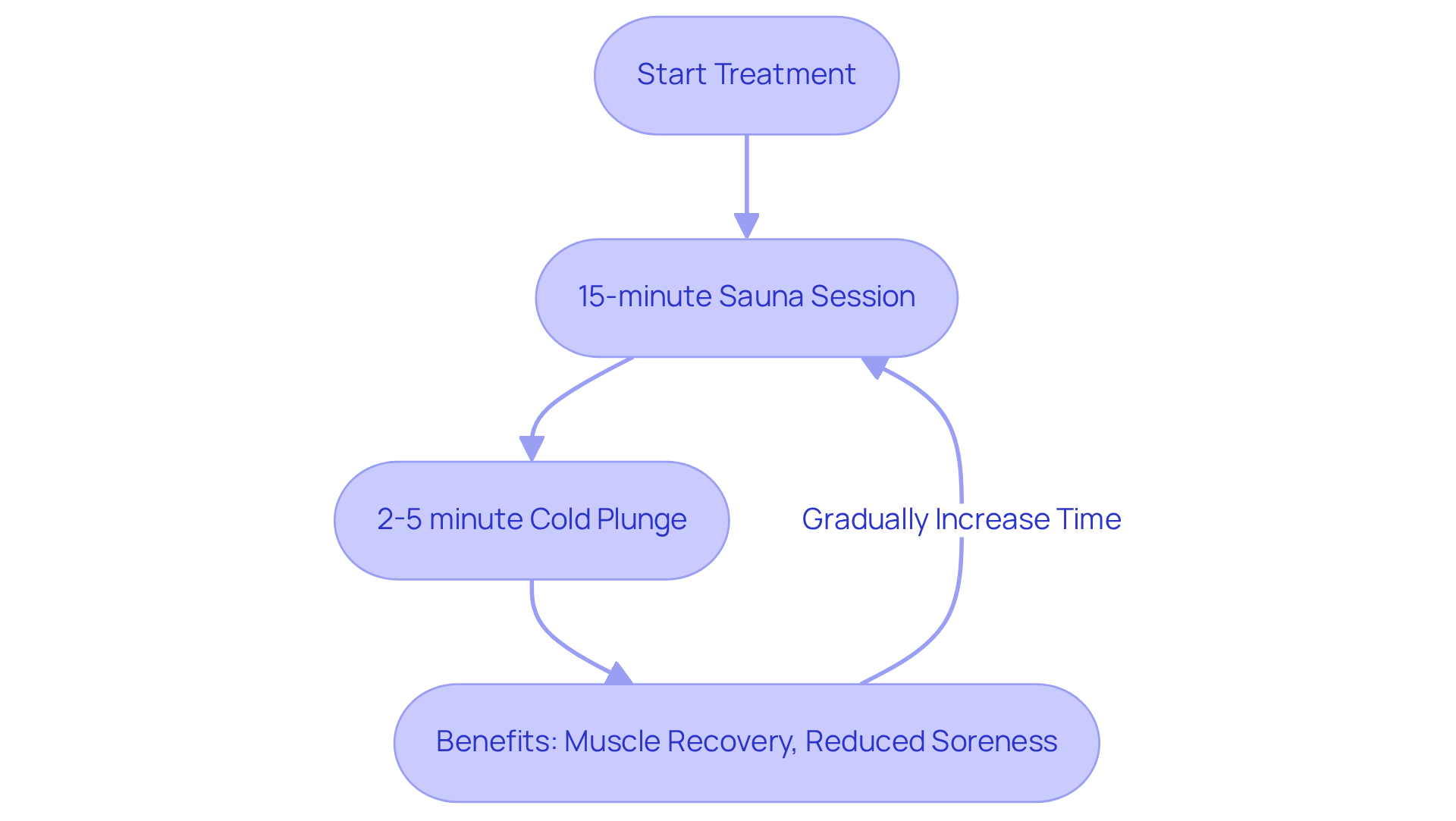
Scientific Insights: Understanding Sauna and Cold Plunge Benefits
Research consistently highlights the extensive benefits of sauna and cold plunge therapies. Regular use of these heat chambers greatly enhances cardiovascular health. Studies suggest that individuals who utilize them four to seven times a week face a 40% reduced risk of dying from any cause in comparison to those who use them less often. This is attributed to enhanced blood vessel dilation and improved circulation, which collectively contribute to better heart health. Additionally, regular use of heat therapy is linked to a 41% reduced risk of pneumonia, further underscoring its respiratory health advantages.
Along with cardiovascular benefits, heat therapy sessions are associated with improved immune function. An 11-year cohort study found that frequent users of heated rooms had a reduced incidence of colds, suggesting that regular exposure to heat may bolster the immune response. Furthermore, heat therapy has been linked to a reduction in depressive symptoms, as warmth exposure can stimulate the release of endorphins, enhancing mood and mental clarity. Notably, sauna use also aids in the excretion of heavy metals through sweat, contributing to detoxification.
Cold immersions, on the other hand, are acknowledged for their capacity to lessen inflammation and speed up recovery. Cold water immersion can significantly lower muscle temperature after exercise, aiding in the alleviation of soreness and inflammation. Studies suggest that low-temperature exposure can increase metabolic rate by as much as 350%, improving energy usage and overall recovery. Furthermore, icy immersions can elevate dopamine levels by 250%, further aiding mood improvement.
Case studies support these findings, showing that individuals who include both heat and cold plunge practices in their routines report enhanced resilience and recovery times. For instance, athletes employing hot-cold contrast techniques have noted improved performance and reduced muscle soreness, underscoring the effectiveness of these methods in athletic recovery.
However, it is essential to consider safety. Individuals feeling unwell or recovering from an illness should consult a healthcare provider before using a heat therapy facility, as it may exacerbate their condition. By understanding the scientific principles behind the benefits of sauna and cold plunge therapies, individuals can make informed decisions about integrating these practices into their wellness routines, ultimately enhancing their overall health and vitality.
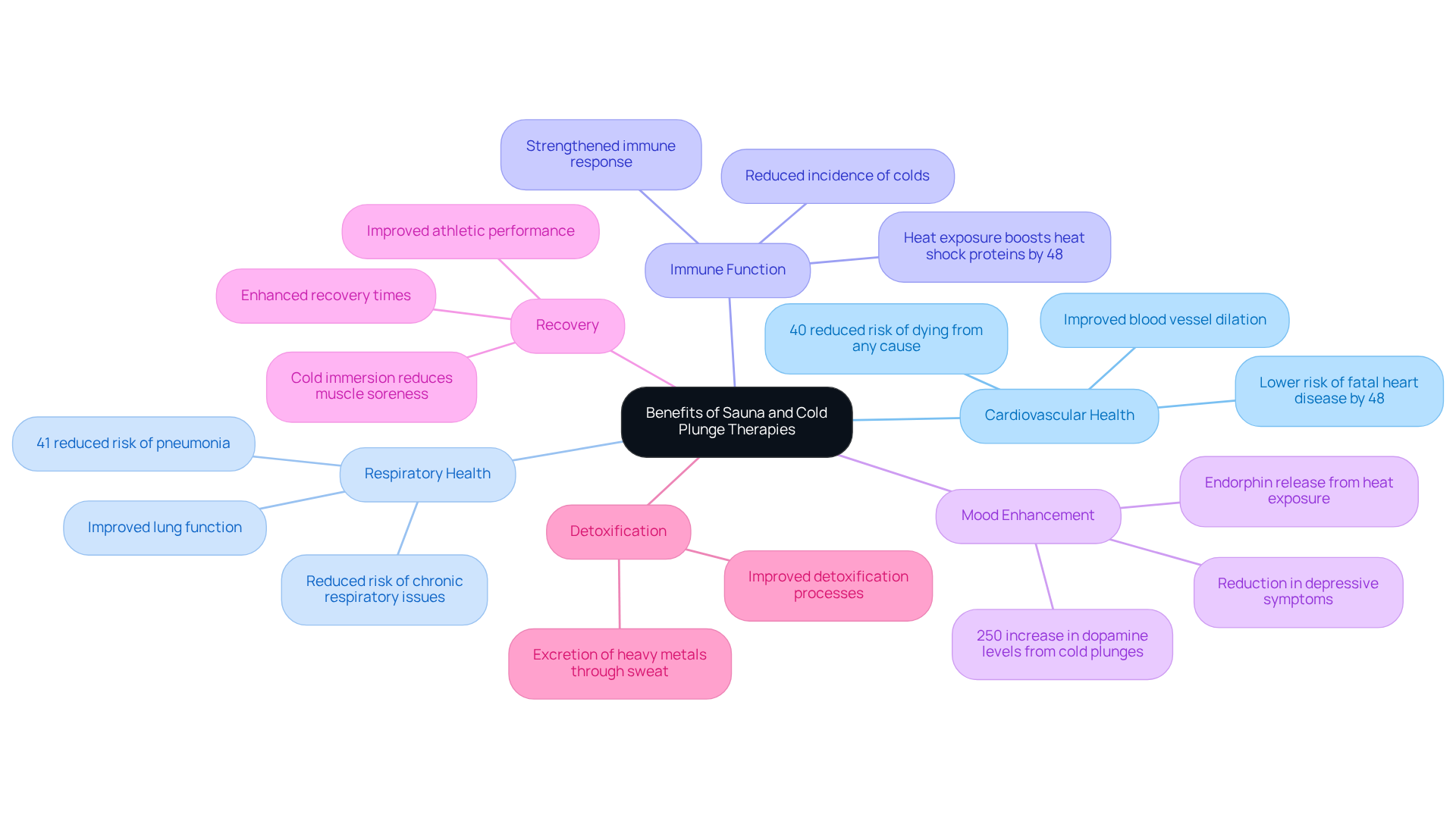
Conclusion
Embracing the powerful practices of sauna and cold plunge therapies can significantly enhance overall wellness. These complementary treatments provide physical benefits, such as improved circulation and reduced inflammation, while also contributing to mental clarity and emotional resilience. By integrating these practices into daily routines, individuals can unlock a holistic approach to health that nurtures both body and mind.
Throughout the article, key insights reveal how regular sauna sessions promote detoxification and cardiovascular health. In addition, cold plunges effectively alleviate muscle soreness and boost immune response. The combination of these therapies, known as contrast therapy, emerges as a vital strategy for recovery and pain management, ultimately fostering a healthier lifestyle. Scientific studies support these findings, underscoring the profound impact of these therapies on longevity and well-being.
Incorporating sauna and cold plunge practices into a wellness routine is not merely a trend but a transformative journey towards better health. Individuals are encouraged to explore the extensive benefits outlined, consider their own wellness goals, and take actionable steps towards integrating these therapies. By doing so, the path to enhanced vitality, resilience, and overall wellness becomes not only achievable but a rewarding experience.
Frequently Asked Questions
What are the benefits of sauna therapy?
Sauna therapy enhances blood flow and circulation, promotes detoxification through sweating, and is associated with improved metabolic function and reduced risk of chronic diseases. Regular sauna use can also lower all-cause mortality and reduce the risk of fatal coronary heart disease.
How long should sauna sessions typically last?
Regular sauna sessions typically last 10-15 minutes.
What is the purpose of cold plunge therapy?
Cold plunge therapy is effective in reducing inflammation and muscle soreness, particularly after intense physical activity. It triggers vasoconstriction, decreases swelling, and facilitates the removal of metabolic waste from muscles.
What temperatures are considered effective for cold plunge immersions?
Effective cold plunge immersions typically have temperatures around 10-15 degrees Celsius (50-59 degrees Fahrenheit).
How do sauna and cold plunge therapies work together?
The combination of sauna and cold plunge therapies, known as contrast methods, enhances circulation by alternating between heat and cold exposure. This method improves cardiovascular health, supports detoxification, and can elevate energy levels and mental clarity.
What should individuals consider before starting sauna therapy?
Individuals with pre-existing health conditions should consult a healthcare professional before adding heat therapy to their routine.
How does cold plunge therapy affect athletic performance?
Cold plunge therapy can speed up recovery, improve perceived recovery and muscle function, and reduce delayed onset muscle soreness (DOMS), allowing athletes to maintain their training intensity.
What additional health benefits can cold plunge therapy provide?
Cold plunge therapy can enhance sleep quality and bolster the immune system, making it a versatile strategy for health and recovery.
How can integrating sauna and cold plunge therapies support healthy aging?
Incorporating sauna and cold plunge therapies into a wellness routine, along with a diet rich in quality animal-based foods, can effectively support healthy aging and rejuvenation.
